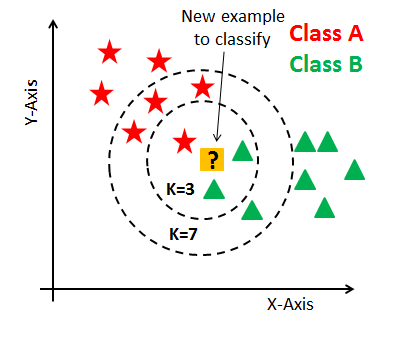K-Nearest Neighbors Classifier
K-Nearest Neighbors (K-NN) is one of the simplest machine learning algorithms. It is a type of instance-based learning where the function is only approximated locally and all computation is deferred until classification. The K-NN algorithm is a non-parametric method used for both regression and classification problems.
When the K-NN is used for classification, the output is a class membership. An object is assigned to the class most common among its K nearest neighbors, where K is a positive integer, typically small. If K = 1, then the object is simply assigned to the class of that single nearest neighbor.

How does it work?
K-NN works on the principle of similarity or proximity. Here are the general steps:
- A positive integer K is specified.
- The K nearest data points are selected based on a distance metric.
- The majority class among the K nearest neighbors is then assigned to the test point.
If a data point is in close vicinity to several points that belong one category, chances are it'll belong to that same category.
Python Implementation
The Scikit-learn library in Python provides a function called KNeighborsClassifier from the sklearn.neighbors package, that can be used to implement K-NN.
from sklearn.neighbors import KNeighborsClassifier
knn = KNeighborsClassifier(n_neighbors=3)
knn.fit(X_train, y_train)
n_neighborsis the parameter to set theKvalue. It's the number of neighbors to consider.fit()function fits the model to the training data.- We can then use
predict()function to predict the class labels.
knn.predict(X_test)
Where X_test is the testing data which the classifier will predict.
Choosing the correct K value
Choosing the value of K can be tricky. A low value for K will be influenced by the noise in the data and a high value will be more computationally expensive. As a general guideline a good starting point for K is sqrt(n) where n is total number of data points.
A commonly used method is to choose K is the cross-validation.
Using the cross-validation, we could calculate the accuracy of the K-NN algorithm for different K values. Then the K with the highest accuracy could be chosen.
Advantages
- No assumptions about data — useful, for example, for nonlinear data
- Simple algorithm — to explain and understand/interpret
- High accuracy (relatively) — it is pretty high but not competitive in comparison to better supervised learning models
Limitations
- Computationally expensive — because the algorithm stores all of the training data
- High memory requirement — Stores all (or almost all) of the training data
- Prediction stage might be slow with big N
- Sensitive to irrelevant features and the scale of the data
In summary, the K-NN algorithm is good for large dataset with fewer attributes (low dimensional space) and where data points are more uniformly spread.
K-Nearest Neighbors (KNN) Classifier
The K-nearest neighbors (KNN) algorithm is a type of instance-based learning, or lazy learning. This classifier algorithm measures the distance between samples and classify them based on it.
Advantages:
-
No Assumption About Data: The algorithm makes no assumption about the underlying data distribution pattern which makes it very useful for nonlinear data.
-
Updating Algorithm: New training examples can be added easily to model, thereby this approach remains robust in changing scenarios.
-
Ease Of Use: It’s a very simple and easy to understand Machine Learning algorithms yet powerful tool,
-
Naturally handles multi-class cases: Different classes in target variable are treated equally irrespective to their frequency.
-
Robust to noisy training data : Works well with noise in the dataset as long as noise does not completely obscure the signal.
Disadvantages:
-
Computationally Expensive: As the dataset grows efficiency or speed of algorithm declines rapidly due to its operation in calculating distances from each point to every other point in the dataset
-
Normalization Of Dataset: Before applying KNN, normalization should always be performed; otherwise higher ranged features might dominate when computing distance.
-
Sensitive To Noisy And Missing Data: Outlier values will mislead prompting faulty analysis
-
Doesn’t work well with high dimensional data: As dimensions increase model begins losing significant performance due “Curse Of Dimensionality”.
-
Dimensions sensitivity : As dimensions/features increases its effectiveness decreases due increased space leading curse dimensionality.
Appropriate Usage Scenarios:
1.K- Nearest-Neighbors widely used for both Classification & Regression predictive problems .
2: If your problem requirement doesn’t involve time constraint you plan on working with small datasets
In those cases where numerical output variable based prediction is not required.
3: Classification problems where you have labelled data such as spam detection,email classification etc
4: Recommender Systems - once trained ,the k- nearest neighbours of product can suggest similar items
5: Features have identical scales – since k-NN work by calculating distances if range are not comparable then normalisation needed else use different approach
May incur problem dealing these scenarios :
-
Large Datasets: Given computational cost typically doesn't turn out huge datasets,
-
High Dimensions: Due Curse dimensionality avoid it using high-dimension spaces.